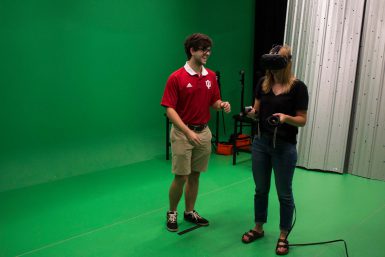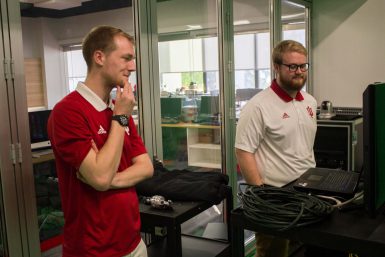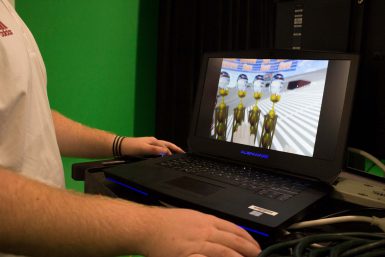Cuban Center VR interns bring IU Athletics to life

Interns at the Mark Cuban Center for Sports Media and Technology are making it possible for Hoosier fans to throw footballs at the 50-yard line inside Memorial Stadium, swing a bat at Bart Kaufman Field and make free throws in Assembly Hall, all from the comfort of their living rooms.
By creating virtual reality games, three Cuban Center virtual reality development interns and Media School students are giving people a new way to experience their favorite sports.
“The Cuban Center is great at sports media technology and kind of pushing this envelope on new tech,” said game design senior Alex Van Halen.
Van Halen worked alongside game design and computer science senior Griffin Park and game design and fine arts junior Devin Good to create the games for the Cuban Center starting in June. The three spent the first six weeks of summer creating an IU football game with four playing modes: target practice, receiver rush, tire toss and quarterback, and then spent the next three creating a two-player home-run-derby-style baseball game.
The games are not out for public use for another month, but new IU football recruits have been able to test the football game during visits. The interns have also brought the game equipment to campus events for students to try. Once they’re ready, they plan to release the games on Steam, a gaming community and platform.

“We’re really one of the only universities in the nation right now that’s doing this sports media tech stuff, so we’re really trying to show that off,” Good said.
The interns use the game design platform Unity to create their game worlds and fill them with pieces they want. Good uses his fine arts background to create the assets in the game, like the football stadium, and then Van Halen and Park work to set up rules and program the game to be playable. From there, they add elements like targets, scoring and timers to provide the most compelling gaming experience in the smallest amount of time. All three agree that building these games from scratch has challenged them and allowed them to do things they wouldn’t normally be able to in a classroom.
“It’s been pretty mutually beneficial,” said Good. “We’ve all gained skills in VR and game development that we wouldn’t have just in classes. It’s also benefiting the Cuban Center and all of IU, because we can send this game out to anybody, and people who really love IU and have never been able to stand on the field can throw on a headset and feel like you’re playing an IU football game, or out on a baseball field or Assembly Hall courts.”

Game development is all about staying ahead of the market trends. By exploring ways the Cuban Center can use VR, these interns are discovering how to stay innovative in a dynamic field. Their next project is to revamp a previously made IU basketball game with the newest technology they have access to and possibly incorporate augmented reality into it. Augmented reality puts digital elements into the real world and is easier to introduce to a mass market because it requires less equipment. Applications like Pokémon GO use augmented reality to allow users to alter the world they already live in.
“There’s something new along the horizon,” said Van Halen. “It’s been great to have a lot of creative freedom with the projects and also have access to all this technology just because we’re part of IU. To represent that has been amazing.”
More:

